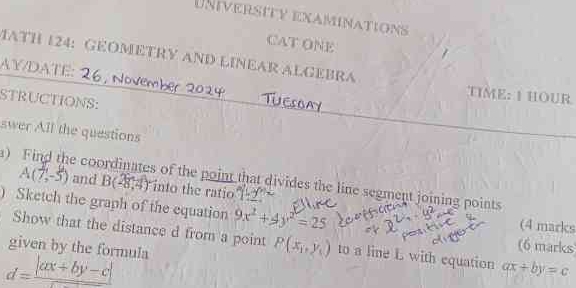Find the coordinates of the point that divides the line segment joining points A(7, 5) and B(2, 3) in the ratio 1:2. Sketch the graph of the equation y = 4x + 5, and show that the... Find the coordinates of the point that divides the line segment joining points A(7, 5) and B(2, 3) in the ratio 1:2. Sketch the graph of the equation y = 4x + 5, and show that the distance d from a point P(x1, y1) to a line L with equation ax + by = c is given by the formula d = |ax1 + by1 - c| / √(a^2 + b^2).

Understand the Problem
The question is asking to perform three tasks related to geometry and linear algebra: finding the coordinates of a point dividing a line segment, sketching a graph of a given equation, and showing how to calculate the distance from a point to a line using a specific formula.
Answer
The coordinates of the point are \( \left(\frac{8}{5}, \frac{2}{5}\right) \) and the distance \( d \) is \( 0 \).
Answer for screen readers
The coordinates of the dividing point ( P ) are ( \left(\frac{8}{5}, \frac{2}{5}\right) ).
The distance ( d ) from point ( P ) to the line is ( 0 ).
Steps to Solve
- Finding the Coordinates of the Point To find the coordinates of the point that divides the line segment joining points ( A(7, -5) ) and ( B(-2, 4) ) in the ratio ( 2:3 ), we can use the section formula: [ P\left(\frac{mx_2 + nx_1}{m+n}, \frac{my_2 + ny_1}{m+n}\right) ] where ( m = 2 ), ( n = 3 ), ( (x_1, y_1) = (7, -5) ), and ( (x_2, y_2) = (-2, 4) ).
Calculating the ( x )-coordinate: [ x = \frac{3(-2) + 2(7)}{2+3} = \frac{-6 + 14}{5} = \frac{8}{5} ] Calculating the ( y )-coordinate: [ y = \frac{3(4) + 2(-5)}{2+3} = \frac{12 - 10}{5} = \frac{2}{5} ] Thus, the coordinates of point ( P ) are ( \left(\frac{8}{5}, \frac{2}{5}\right) ).
- Sketching the Graph of the Equation The given equation is ( y = 4x + 3 ). To graph this equation, we can find its intercepts.
Finding the y-intercept by setting ( x = 0 ): [ y = 4(0) + 3 = 3 \quad \text{(point (0, 3))} ] Finding the x-intercept by setting ( y = 0 ): [ 0 = 4x + 3 \implies 4x = -3 \implies x = -\frac{3}{4} \quad \text{(point (-\frac{3}{4}, 0))} ] Plotting these points on a coordinate system and drawing a line through them gives the graph of the equation.
- Calculating the Distance from a Point to a Line To find the distance ( d ) from point ( P(x_1, y_1) ) to the line ( ax + by = c ), we use the formula: [ d = \frac{|ax_1 + by_1 - c|}{\sqrt{a^2 + b^2}} ] For instance, if the line is ( 4x - y = 3 ) (so ( a = 4, b = -1, c = 3 )) and the point ( P\left(\frac{8}{5}, \frac{2}{5}\right) ), we calculate: [ d = \frac{|4\left(\frac{8}{5}\right) - 1\left(\frac{2}{5}) - 3|}{\sqrt{4^2 + (-1)^2}} = \frac{|\frac{32}{5} - \frac{2}{5} - 3|}{\sqrt{16 + 1}} = \frac{|\frac{30}{5} - 3|}{\sqrt{17}} = \frac{0}{\sqrt{17}} = 0 ] This shows point ( P ) is on the line.
The coordinates of the dividing point ( P ) are ( \left(\frac{8}{5}, \frac{2}{5}\right) ).
The distance ( d ) from point ( P ) to the line is ( 0 ).
More Information
Finding a point dividing a segment and calculating distances from points to lines are fundamental concepts in geometry and linear algebra. Mastery of these concepts can simplify many mathematical problems.
Tips
- Forgetting to convert ratios into correct coefficients when applying the section formula.
- Miscalculating intercepts when graphing lines.
- Not carefully substituting the coordinates into the distance formula, leading to errors.
AI-generated content may contain errors. Please verify critical information